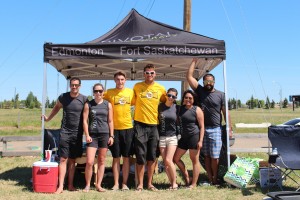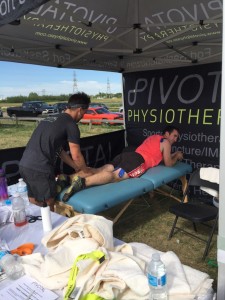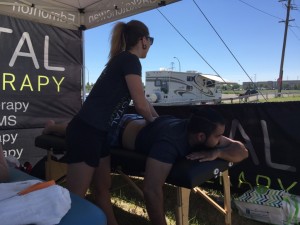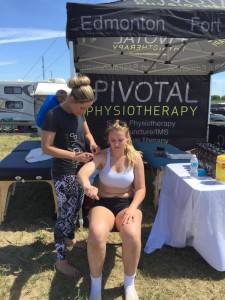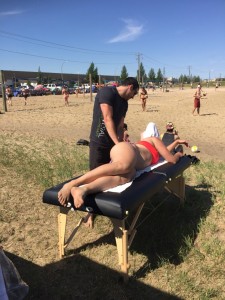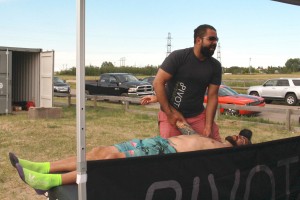This year, Pivotal Physiotherapy volunteered our services at the first annual Bounce Fest Beach Volleyball tournament weekend (Sat June 27 & Sun June 28 2015). This was one of the hottest weekends this summer and we (still) have the tan lines to prove it! Along with the perfect beach volleyball weather, we were surrounded by many passionate players, which created a fun and vibrant atmosphere. The tournament, organized by Tanner Nault and Spencer Leiske from 24th Street Entertainment, was a success and we can’t wait to be part of its growth in the upcoming years.
Nicolas Pahud MPhtySt and Sunny Deol MScPT treated many athletes throughout the weekend, rehabilitating old injuries and fixing up new ones. Due to the overwhelming presence of our sun shiny friend, we also fixed up some blisters acquired from playing in the scorching hot sand, ouch! Our assistants provided extra help to stretch out and tape up some athletes while our physiotherapists were busy (not at the beer gardens).
Joey Vos BScKin
Kaitlyn Skaley BScKin
Kaylee Kothke BScKin
Common volleyballer injuries:
1. Hyperextension of the Lumber Spine
“Although volleyball is a relatively safe sport compared to other collision sports, it does offer unique injury patterns; particularly overuse injuries of the back. Low back pain in beach volleyball players is relatively common because of repetitive rotating and bending of the trunk. The stress and neuromuscular demand is further amplified by the capriciousness of playing in the sand. Strains and sprains of the lower back is the most common back injury although the repetitive hyperextension during hitting, serving and setting can also place large amounts of pressure on the bones of the lumbar spine. This can occasionally lead to stress fractures of the vertebra, known as spondylolysis.
Research has demonstrated that a stable, well-conditioned “core” plays a critical role in coordinating movements and in minimizing the athlete’s risk of lower back injuries. Often when treating a volleyball player, I assess the player’s ability to produce smooth efficient movements, noting core and pelvic muscle activation or pathological compensation patterns generated. Athlete’s are then treated accordingly with the focus typically involving muscle release and joint mobilization of the pelvis and the thoracolumbar spine.” – Nicolas Pahud MPhtySt
Nicolas Pahud MPhtySt
2. Pain and stiffness in the Shoulder Joint
“I would like to first like to thank the organizers of Bounce Fest to allow us to treat and participate in the event. I had an amazing experience watching some great games, treating athletes, and enjoying the beautiful weather. It was great to see athletes from across the province participate in an event like this. I played volleyball in my high school years so I had a strong interest when the opportunity to volunteer came around.
I had the opportunity to work with multiple athletes during the tournament that had pain and stiffness associated with their shoulder joints. Since volleyball is an overhead sport that involves high forces and loads throughout the shoulder complex, athletes can experience injuries associated with this joint. The shoulder joint is relatively unstable and relies on the capsule, ligaments, and surrounding muscles for support. Due to these factors, rotator cuff strains are common with volleyball. I had the chance to perform joint mobilization and release of surrounding tissues with the athletes I treated, along with providing them exercises to strengthen and stretch the joint/capsule. If you yourself experience a shoulder injury especially with overhead sports it is always a good idea to visit your friendly neighbourhood physiotherapist!” – Sunny Deol MScPT
Sunny Deol MScPT
Nicolas Pahud MPhtySt
Sunny Deol MScPT
Written by Cathy Ocol VP Public Relations

